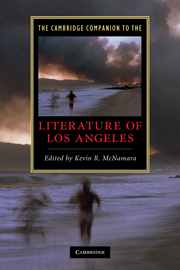Book contents
- Frontmatter
- Introduction: landmarks
- 1 The literature of the Californios
- 2 The Anglo invention of Los Angeles
- 3 LA fiction through mid-century
- 4 British expatriates and German exiles in 1930s-1940s Los Angeles
- 5 Postwar Los Angeles: suburban Eden and the fall into history
- 6 Los Angeles and the African-American literary imagination
- 7 Pacific Rim city: Asian-American and Latino literature
- 8 The literature of urban rebellion
- 9 City of sleuths
- 10 Los Angeles’ science fiction futures
- 11 Hollywood fictions
- 12 The Southland on screen
- 13 Scenes and movements in Southern California poetry
- 14 Surf, sagebrush, and cement rivers: Reimagining nature in Los Angeles
- 15 Essaying Los Angeles
- Guide to further reading
- Index
8 - The literature of urban rebellion
Published online by Cambridge University Press: 28 May 2010
- Frontmatter
- Introduction: landmarks
- 1 The literature of the Californios
- 2 The Anglo invention of Los Angeles
- 3 LA fiction through mid-century
- 4 British expatriates and German exiles in 1930s-1940s Los Angeles
- 5 Postwar Los Angeles: suburban Eden and the fall into history
- 6 Los Angeles and the African-American literary imagination
- 7 Pacific Rim city: Asian-American and Latino literature
- 8 The literature of urban rebellion
- 9 City of sleuths
- 10 Los Angeles’ science fiction futures
- 11 Hollywood fictions
- 12 The Southland on screen
- 13 Scenes and movements in Southern California poetry
- 14 Surf, sagebrush, and cement rivers: Reimagining nature in Los Angeles
- 15 Essaying Los Angeles
- Guide to further reading
- Index
Summary
Los Angeles' “coolie riots” of 1871, in which nineteen Chinese were “hanged and shot in one evening,” never attained literary memorialization; but they confirmed a trend that was to become typical of Los Angeles, where riots tended to be upsurges of public violence against scapegoat minorities. The first such pseudo-event to receive literary attention was the “Red hysteria” of 1919. As Los Angeles adapted to the afterglow of the Great War, the anti-Bolshevik propaganda emanating from Washington percolated down into everyday acts of violent anti-Leftism. Police Chief George K. Home raided the Industrial Workers of the World hall on October 2, and crowed to the press that the “cleanup” would continue “until the last of their number has been placed behind bars or driven from the city.” Servicemen and citizens took this task into their own hands: “about twenty-five men in full uniform of the Army and Navy together with a few civilians raided the IWW headquarters. . . while a 'defense' meeting was in progress, drove out the occupants, hospitalized four, and demolished the furniture and equipment. Five of the alleged IWW members were arrested and charged with inciting a riot.” The incident was processed into the climax of Upton Sinclair's 1927 epic, Oil!: “There came rushing down the street a squadron of motor-cars, two abreast and blocking the way entirely; and from them leaped a crowd of some fifty men, carrying weapons of various sorts, clubs, hatchets, pieces of iron pipe. They made a rush for the entrance [of the IWW hall], and a moment later the music ceased, and there came a sound of shrieks, and the crash of glass and battering of heavy blows.”
- Type
- Chapter
- Information
- The Cambridge Companion to the Literature of Los Angeles , pp. 101 - 110Publisher: Cambridge University PressPrint publication year: 2010

